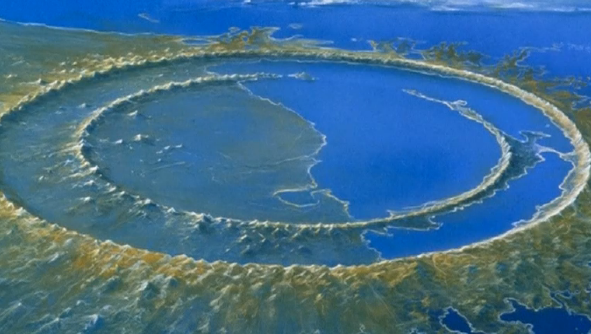
MEXICO CITY, Mexico (Reuters) – An international research team has started drilling for core samples nearly 1,500 meters (nearly 5,000 feet) below the seabed of a prehistoric crater left by an asteroid collision in Mexico’s Yucatan Peninsula that many believe killed the dinosaurs.
The samples could yield clues about how life recovered after the cataclysm. They will also look into whether the 110-mile-(180-km-) wide crater itself could have been a home for microbial life. Scientists also hope to shed light on how such “peak rings” of the crater took shape, according to an article published in the journal Science.
Scientists obtained a $10 million dollar fund for the expedition from the International Ocean Discovery Program (IODP) and the International Continental Scientific Drilling Program.
The two-month-long expedition supports the theory first proposed in 1980 that the dinosaurs’ extinction, about 66 million years ago, was linked to an asteroid impact. The biggest piece of evidence for this theory, has been the so-called Chicxulub (pronounced “cheek’-she-loob”) crater off the Yucatan coast in Mexico.
At the end of last month, a specially equipped vessel set sail from the Mexican port of Progreso to a point 30 kilometres offshore to set up a platform and start drilling.
Many scientists believe the impact wiped out most large animals and plants, killing the dinosaurs and large marine reptiles.
There are very few geologic samples of the now-buried impact crater, according to information published by Science.
The expedition will be led by a team of scientists from the UK and US as well as geologist Dr. Jaime Urrutia-Fucugauchi, of the Geophysics Institute at the National Autonomous University of Mexico (UNAM).
“The impact at Chicxulub is one of these events that mark the evolution of life on earth. The impact caused the extinction of some 75 percent of species that existed in that period and literally three of every four species are wiped out due to the effects of the impact. It marks the transition of what colloquially, we know are the era of the dinosaurs to the era of the mammals,” Urrutia-Fucugauchi said.
Apart from studying the structure of the peak ring rocks, researchers are also interested in finding out what life they might host. Scientists have already concluded the rocks are porous and fractured in places and will look into whether any microbes are still living in the fractures.
This would show the impact crater heralded death but was also a habitat for life, according to an article published in Science.
The expedition will provide a more detailed picture of what happened 66 million years ago, according to Ligia Perez Cruz, of the Geophysics Institute at the UNAM.
“We’ll be able to have, in this case, a continuous perforation and we’ll be able to probably have a registry of higher temporary resolution and with more fidelity of what happened during the last 65-66 million years. That’s the greatest advantage, obtaining a complete, continuous sample. We are talking about a 1,500 metres deep sample,” Perez Cruz said.
Once extracted, the core samples will be shipped to Germany and split in two. Half will be immediately analysed by an international team of scientists from the U.S., U.K., Mexico and other nations, and half will be saved at a core repository at Texas A and M University for future research needs by the international community, according to official sources.








